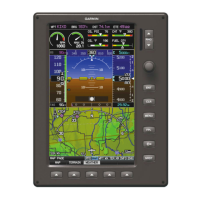190-01115-01 G3X™/G3X Touch™ Avionics Installation Manual
Rev. AV Page 19-5
19.5 Antenna Considerations
This section contains mounting location considerations for the antennas required for the GTR 20. For
mounting the COM antenna, refer to the aircraft manufacturer’s data.
19.5.1 COM Antenna Location
The GTR 20 COM antenna should be well removed from all projections, engines and propellers. The
ground plane surface directly below the antenna should be a flat plane over as large an area as possible (18
inch square, minimum). The antenna should be mounted a minimum of six feet from any DME or other
COM antennas, and four feet from any ADF sense antennas. The COM antenna should also be mounted as
far as practical from the ELT antenna. Some ELTs have exhibited re-radiation problems that cause
interference with other radios, including GPS. This can happen when the COM (GTR 20 or any other
COM) is transmitting on certain frequencies such as 121.15 or 121.175 MHz, which may cause the ELT
output circuit to oscillate from the signal coming in on the ELT antenna coax.
If simultaneous use of two COM transceivers is desired (split-COM or simul-comm), the COM antennas
should be spaced for maximum isolation. A configuration of one topside antenna and one bottom side
antenna is recommended. The GTR 20 requires a transmit interlock.
Simultaneous COM performance varies significantly across installations and is affected by both the
isolation between the COM antennas and the separation of the tuned frequencies. Each installation should
be individually examined to verify the expected performance of simultaneous COM.
CAUTION
Garmin recommends the COM antenna be mounted a minimum of six feet from any other
COM antennas. For aircraft which cannot comply with the recommended separation,
COM antenna spacing should never be less than three feet to reduce the chance of damage
to the COM receiver. All dual COM installations must use the GTR 20 interlock. An
example of direct line of sight is both antennas mounted on the bottom or top surface of
the aircraft. For metallic aircraft, it is recommended that one antenna is mounted on the
bottom close to the front and the other on the top of the aircraft close to the tail so the
aircraft structure is between the two antennas. For composite aircraft, additional
shielding may be needed between top and bottom mounted COM antennas.
NOTE
Canadian installations are required to meet Industry Canada specifications for maximum
radiation as documented in Radio Specifications Standard 102 (RSS-102). For more
information about RF exposure and related Canadian regulatory compliance, contact:
Manager, Radio Equipment Standards
Industry Canada
365 Laurier Avenue
Ottawa, Ontario
K1A 0C8
In accordance with Canadian Radio Specifications Standard 102 (RSS 102), an RF safety
separation distance of 26 cm from the antenna should be maintained for an RF field
strength exposure to persons of less than the 10W/m
2
occupational safety limit.
Under Industry Canada regulations, this radio transmitter may only operate using an
antenna of a type and maximum (or lesser) gain approved for the transmitter by Industry

